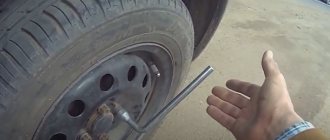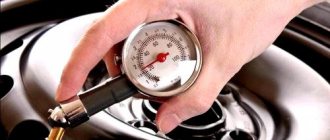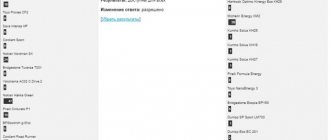• Heating of tires from sunlight can significantly affect tire pressure, remember this when taking measurements on each side of the car.
• You should not overinflate tires to save fuel; the savings will be very insignificant considering the future costs of repairing the chassis and replacing worn out tires.
• When using all-season tires, the pressure decreases with the cold weather; do not forget to inflate the tires when the season changes.
• When using pumping at a gas station, check the final pressure with your pressure gauge; gas pumps are usually inaccurate due to poor condition.
• The pressure range indicated on the sidewall of the tire is the maximum permissible for the tire when it is cold.
• If you still decide to keep the pressure at maximum, never exceed the values indicated on the tires themselves.
Source
What should the tire pressure be?
The manufacturer of both the car and the tires always recommends maintaining a certain tire pressure, and the tire pressure on both the front and rear axles does not necessarily have to be the same. It all depends on the load on the car, weight distribution, and weather conditions.
If the wheel has high pressure, then:
If the tire has low pressure:
The tire consists of 2 main parts: Tread and sidewall. The protector is a dense material that is not very susceptible to deformation. The sidewall, on the contrary, suffers greatly from both low and high pressure.
At low pressure, it is possible that the rim of the disk will cut through the tire on a bump or hole, and you, at best, will not be able to continue driving on such a “wheel.” And with high pressure, upon impact, a hernia may pop out or simply burst. But we are talking about pressure 2 to 3 times higher than normal; if you overinflated the tire by 10-15%, then there is nothing catastrophic about it.
Optimal tire inflation for various situations
In this section we will talk about what pressure should be in the tires of a VAZ 2114 passenger car with a 14 radius in the summer and why. This information applies to wheels of other sizes, taking into account that the larger the rim diameter, the more the tire needs to be inflated. Increasing the size by 1 inch (instead of R13, put R140), increases the requirement for air compression inside the tire by 0.1–0.2 atm.
In summer on a dry asphalt road
To drive on a dry asphalt road and air temperature above +10 degrees and a standard load (5 people, each weighing 70 kg and 50 kg of cargo), the tires of a VAZ 2114 13 radius passenger car in summer should have a pressure of 2–2.2 atm in the front and 2 ,2–2.4 atm at the rear.
What should be the air pressure in the tires?
The VAZ manufacturer recommends setting the tire pressure at 1.9 (kgf/cm2). You can also set the tire pressure to 2(kgf/cm2). For a more accurate determination of pressure, look at the formula in the table.
The manufacturer recommends setting the pressure at 2 (kgf/cm2). For a more accurate determination of pressure, look at the formula in the table.
Setting tire pressure does not depend on the radius and size of the tire, but depends on the load. Therefore, the values for all radii are approximately the same. The manufacturer recommends setting the pressure at 2 (kgf/cm2).
For a more accurate determination of pressure, look at the formula in the table.
What pressure should be in VAZ tires
VAZ cars can be considered one of the most famous brands in the post-Soviet space. Today you can find both old VAZ-2106 and 2107 models. Samara 2109 and 21099 are quite common. Fans of the domestic automobile industry today purchase more modern models: VAZ 2110, 2112, 2114 and 2115 . This suggests that even with the appearance on the market of a large number of affordable foreign cars, cars from the Volzhsky plant have not ceased to be in demand among car enthusiasts.
It is important to always know the tire pressure of your car
In order for the service life of the car to be long enough, it is necessary to strictly adhere to all conditions of proper operation. Among the various factors that determine the proper use of a car, tire pressure is very important and significant.
What non-standard sizes can be supplied?
Installing wheels with a diameter or width larger than the standard size may cause a malfunction. Before purchasing, you must ensure that the installation is safe. A good solution is a preliminary “trying on”. You should install the wheels before purchasing. It is especially important to check the front tires: they should not touch the fender liners or the car body.
Often, too high a tread height leads to contact with the fender liners. This can have serious consequences:
- damage to the plastic of the wheel arches;
- mudguards become damaged and cease to perform their function;
- Cavities and rust appear at the points of contact between the tread and the paintwork.
The latter is especially dangerous. Since unprotected metal rots quickly, literally within 1 winter. AvtoVAZ cars have never been famous for their high-quality anti-corrosion treatment. Also, increasing the weight of the wheel by literally a few kilograms will lead to accelerated wear:
- wheel bearings;
- shock absorber struts and other suspension elements.
The manufacturer allows the installation of the following non-standard tire diameters on VAZ 2110 vehicles and modifications:
The diameter of R14 is typical and relatively small. It is allowed to use tires with a tread width of up to 185 mm and a height of up to 75-80. Tires with a diameter of 15 inches are also usually installed on this car without any problems. R16 is a tire that requires some driving skill. Since this diameter is not standard, the machine is not designed for this weight and size.
R17 and R18 can only be installed after some modification using a special roller - the wheel arches simply “roll out”. This will avoid contact between tires and body parts. Also, constant friction of the tread on the fender liners will cause the pattern to quickly wear off and lead to deterioration of the wheel’s grip on the road.
Car tire pressure, how important is it?
The manufacturer always gives recommendations regarding the tire pressure of the car. There is a special table where, depending on the model and type of tire, it is indicated what the value should be for different types of cars.
However, we should not forget that it also depends on load distribution, ambient temperature and other factors.
Control measurement of tire pressure on a VAZ 2106 car
With overinflated wheels we observe the following:
When the wheels are underinflated, the following phenomena are observed:
In both the first and second cases, tread wear increases. In the first case, the middle of the tread deteriorates, in the second, the sidewalls.
Review of the best summer and winter tires
It is better to acquire separate sets of summer and winter tires in advance. Pirelli Cinturato P1 Verde tires are ideal for the warm season. Their cost is relatively high (from 3,500 rubles per 1 tire). However, they perform excellently on wet asphalt and are highly resistant to wear.
- Continental Conti Premium Contact 5 is well balanced. There are a large number of special drainage channels - they make it easy to drain water from the contact patch. This kit will cost slightly less than the one discussed above.
- Goodyear EfficientGrip Performance provides good grip and low fuel consumption. However, the tread thins out quite quickly - especially during intense driving. The rubber is soft and handles well. Despite its softness, it is difficult to damage it redder.
- Dunlop Sport BluResponse is relatively cheap compared to all the options discussed above. However, it has its weaknesses. For example, on wet asphalt the wheels slip a lot and handling deteriorates.
- Semperit Comfort-Life 2 is a rare guest on Russian territory. However, on dry asphalt at positive temperatures it performs more than well. However, rubber is distinguished by its noise.
- GOODYEAR 175/70R14 UG ICE ARCTIC D-STUD - studded tires at a relatively low cost. Regardless of the ambient temperature, it retains its flexibility and softness. Cost – from 4,000 rubles.
- HANKOOK 175/70R14 W429 is a more budget option. Cost – from 2,800 rubles. Thanks to the deep tread and flexible design, the driver can feel completely safe on the road.
- KUMHO 175/70R14 WI31 84T usually costs several hundred rubles cheaper than the modification discussed above. The presence of studs makes this tire safe on almost any road.
- VIATTI TIRES 175/70R14 BRINA NORDICO is manufactured using rubber mixing technology. Reinforced lugs make this model indispensable not only in winter, but also on dirt roads in summer.
- SAVA 175/70R14 ESKIMO ICE MS is the most profitable option. It has a relatively low price (from 2,000 rubles). There are no thorns. However, the deep tread and its shape provide high-quality, reliable contact with any surface.
Choosing suitable tires for the VAZ 2110 is a relatively simple process. However, it is important to familiarize yourself with the intricacies of tire selection in advance. Wheels that are too large can easily damage the vehicle body.
Source
Tire pressure table for different VAZ car models
The table below shows what the tire pressure should be for various VAZ car models. We provide an incomplete list, older types, like the VAZ-21099, and newer cars: VAZ-2110, 21111 and 21112.
Table of recommended tire pressure for VAZ cars
In winter, it is customary to lower the wheels a little, although it is officially stated that the degree of inflation does not depend on the season. However, lowered wheels provide the following advantages:
Tire pressure in winter for VAZ and Lada Priora, Kalina, Granta
With the arrival of cold weather, domestic motorists should take into account that the pressure in the tires of a VAZ car in winter needs to be more carefully monitored. As the air cools, it compresses, which leads to a drop in inflation and driving on empty tires. The result is intense wear and deterioration in performance.
The degree of pumping depends on the temperature difference. For example, a car in a garage has its wheels inflated to 2.2 At, while driving outside, where it is -20 °C, the value will quickly drop by 0.3 units. Moreover, the greater the difference, the stronger the air compression.
Check your car tire pressure regularly
Owners of VAZ cars, like any other brands, are recommended to regularly check the level of tire inflation - at least once a month. Practice shows that over the course of a month the pressure decreases by 0.4 atmospheres. In this case, it is necessary to pump up the wheels.
To measure, you don’t have to constantly go to a service station - you can do it yourself using a pressure gauge. We do it this way:
Since temperature can significantly affect the readings, it is necessary to take them before leaving the garage on “cold” tires. Remember that regular monitoring is the key to your safety and long vehicle life.
Tire pressure for front-wheel drive VAZ cars: popular radii and profiles
The vehicle tire pressure must be checked regularly and maintained at the values recommended by the vehicle manufacturer. Deviation from the established norm can lead to a variety of consequences, and most importantly, traffic safety depends on it. What pressure should be in the tires and what it affects, we’ll look at it in a little more detail in this article.
Measuring tire pressure with a pressure gauge
WHAT IS THE RISK OF DEVIATION FROM THE SET PARAMETERS
Front-wheel drive cars of the Volzhsky Automobile Plant, such as the VAZ 2110, VAZ 2114 and VAZ 2115, can be equipped with wheels with a radius of R13, R14, R15 and R16, but the standard cars are equipped only with rims and tires of the 13th and 14th radius. The optimal tire pressure depends primarily on the load and weight of the vehicle; much also depends on road conditions and ambient temperature.
If the wheels are poorly inflated, then:
If the wheels are inflated more than normal, then this is also not very good:
Below are three pictures that show how the rubber tread adheres to the road at optimal, low and excess pressure.
Many car owners are wondering what pressure should be in R14 tires on VAZ models. According to technical conditions, the wheels on a VAZ 2114 (2115) car are inflated to 1.9 kgf/cm² (R13), on VAZ 2110-2112 cars it is recommended 2.0 kgf/cm² (R14). Moreover, it makes no difference what axle the wheels are on - front or rear.
Inflating wheels
Let's summarize: front - 2, rear 2.2 when driving with a full load or at speeds above 160 km/h)))
increase pressure by 0.2 atm
Physics. 6th grade. Remember isobaric, isochoric and isothermal processes.
Under load, the volume of the cylinder decreases. Means what? Pressure and temperature will increase. Temperature - the cylinder will cool down. All that remains is an increase in pressure.
The tire has cord. It prevents the balloon from inflating.
By the way, I noticed it a long time ago. When the outside temperature drops below 0, the tire pressure increases slightly. I associate this with a decrease in the elasticity of the rubber and cord.
I’ll join you with my question. Let’s say that on a medium-long trip (to the country, to the village, etc.) you discovered that: 1. The wheels need to be pumped up 2. The pump does not have a pressure gauge or the pressure gauge is broken.
What methods for determining the pumping rate exist? What regulations for these methods must be observed?
The phrase “You have discovered that: 1. The wheels need to be pumped up”
means you already have the criteria. Otherwise, how did you discover this?
Nevermind A specific situation that happened to a wheel on a friend’s car - the spool was loosened due to vibrations, thanks to which almost all the air was bled out in 18 hours. I poked my head into the trunk behind the pump - the pump was pumping, the pressure gauge was glitching, showing the weather on Mars. Before this the pressure gauge worked.
PS: the situation was resolved by pumping up according to the method proposed just above - the degree of rubber dent in comparison with the indicators for the other wheels. Then I drove up with a pump and a pressure gauge - it was inflated at +0.1 atm compared to the second front wheel.
Source
INFLUENCE OF WEATHER CONDITIONS AND ROAD FACTORS
The pressure in VAZ tires in summer should, in principle, be the same as in winter. But in practice in winter it is made a little lower for a number of reasons:
It is necessary to take into account the fact that after a temperature change (after leaving a warm garage on a frosty street), the pressure in the R14 tires will become less due to physical factors. Therefore, you should check it before you hit the road and, if necessary, pump up the tires. Also, when it gets warmer after winter, pressure measurements should be taken.
The pressure in R13 tires in summer is usually maintained at 1.9 atm, but this level is designed for an average vehicle load (two or three people in the cabin). If the car is fully loaded, then the pressure should be increased on the front axle to 2.0-2.1 atm., on the rear axle to 2.3-2.4 atm. The spare wheel is inflated to 2.3 atm.
Russian roads are not of good quality, and therefore many car owners deliberately lower the tire pressure somewhat so that all the unevenness of the road surface is not so noticeably felt when driving. Typically, in summer the wheels are lowered by 5-10%, and in winter by 10-15% of the norm. On flat roads you can stick to the factory standard.
For example, a table of car tire pressures:
For example, a table of car tire pressures
Recommendations from motorists
Car enthusiasts set their own limits. Factory criteria may not fully meet user requirements, which encourages them to experiment.
As a rule, most buyers complain about excessive harshness. Thus, the tire pressure on the Lada Kalina in winter is kept within the range of 1.8-1.9 At. On Largus, drivers are not advised to overinflate the wheels and keep the inflation level at 2.2 kg.
Special attention is paid to overcoming obstacles, fords and snowfalls. The optimal pressure here is usually much lower than under nominal conditions. Some motorists even lower their tires to 1 At. but after driving on a good road, the indicator must be returned to the established limits.
The pressure in VAZ tires in winter completely depends on the requirements of the plant and the design features of the car. The service manual can tell you the level of inflation. At the same time, it is necessary to comply with the rules in any conditions. Otherwise, the risk of the car skidding or wheel damage increases, which is unsafe on the road.
LARGER DIAMETER WHEELS
From the factory, the installation of wheels with diameters R15 and R16 is not provided, but some car enthusiasts, in pursuit of fashion and improved technical characteristics, install them on their VAZs. And accordingly, you need to know what the pressure should be in the R15 tires, and what the pressure should be in the R16 tires. It all depends on the workload of the VAZ model. With an average vehicle load, the wheels are inflated to 2 kgf/cm²; on a loaded car, it is better to inflate them to 2.2 kgf/cm². And if there is a lot of heavy luggage in the trunk, then the rear tires are pumped up by another 0.2 kgf/cm². It turns out that the pressure in R14 tires is approximately the same as the pressure in R15 and R16 tires (for VAZ 2110-2115 models).
What determines wheel inflation/pressure in R13 winter tires?
The difference in the degree of tire inflation depends on the basic parameters of the car:
- Gross vehicle weight with or without loading. With a loaded car, the wheels are pushed through more than with an empty trunk and driver.
- Cylinder dimensions. Tire cavity capacity is of primary importance. For example, the pressure in winter tires R13 VAZ 2106 and R 16 on Vesta will differ by an average of 0.4 BAR.
- Speed index. At high speeds and driving on smooth asphalt, an improved free run is required. At the same time, for off-road modifications – this is not necessary.
METHODS OF MEASUREMENT
How to measure the tire pressure of VAZ cars? The measurement can be made using a special dial pressure gauge, but it should be noted that they may have an error of 0.2 atm. The pressure gauge can be either a separate device or as part of a wheel inflation pump.
We measure the pressure very simply:
It is recommended to take measurements at least once a month if the machine is used regularly. It is recommended to check tire inflation before leaving the garage after a long stay.
Pressure may increase when tires heat up. This often happens if the driver prefers a dynamic driving style with frequent and sharp braking. Therefore, measurements are taken on the car before the trip, when the wheels have not yet warmed up.
Features of tire inflation in winter and summer
As mentioned above, you need to check the density of tires on a cold car. It is also better to inflate tires, especially in winter, not immediately after using the car, but when the wheels “cool down” a little. This rule applies to both winter and summer maintenance. In winter, we measure the pressure and pump up the tires no earlier than 2 hours after stopping. In summer, due to the high ambient temperature, cooling occurs much more slowly, this should also be taken into account. In winter, the ideal option would be to inflate tires in a warm box or tire shop; this will help to avoid differences in pressure, and in this case the indicators will be close to ideal.
Please note that if the car is fully loaded, the pressure in the tires will increase significantly, this should also be taken into account. Significant changes will also occur when the ambient temperature fluctuates greatly. Therefore, when the weather changes, you need to measure the tire pressure more often.











